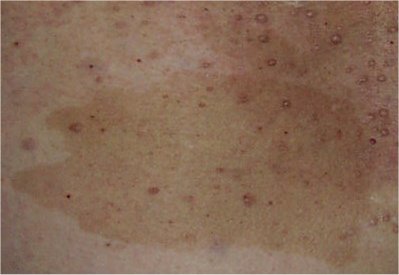Neurofibromatosis Type 1

Neurofibromatosis type 1 (NF1) is a clinically heterogeneous, neurocutaneous genetic disorder characterized by café-au-lait spots, iris Lisch nodules, axillary and inguinal freckling, and multiple neurofibromas.
Epidemiology
Prevalence is reported to be 1/3,000 live births. NF1 is reported in many ethnic groups and affects males and females equally.
Clinical description
The clinical features are highly variable, even within the same family. Multiple café-au-lait macules are found in almost all patients (some at birth and most before the first year). Intertriginous freckling develops starting at 5 years of age. Multiple cutaneous and subcutaneous neurofibromas develop in adults. In older patients, they continue to increase in number and size. Cutaneous neurofibromas do not become malignant. Plexiform neurofibromas (growing along the nerve and its branches) may cause disfigurement, pain, and functional problems and are usually present at birth and may become malignant later in life. Ocular manifestations include optic pathway gliomas and iris hamartomas (Lisch nodules). Optic pathway gliomas usually develop before age 6 years, and rarely progress thereafter. Osteopenia, osteoporosis, bone overgrowth, short stature, macrocephaly, scoliosis, skeletal dysplasia (sphenoid wing, vertebral), and pseudoarthrosis may be present. Other features include hypertension, vasculopathy, intracranial tumors, malignant peripheral nerve sheath tumor (MPNST; see this term), and occasionally seizures or hydrocephalus. Intellectual development is usually not severely affected but cognitive deficits and learning difficulties are frequent (50%-75%). The overall cancer risk is higher than the general population (lifetime risk of 10-12% for MPNST, mostly between 20-40 years; increased risk of breast cancer before age 50). Familial spinal and segmental forms of NF1 have been described. Watson syndrome forms part of the NF1 spectrum. Neurofibromatosis-Noonan syndrome is a variant of NF1 in 99% of cases (see these terms).
Etiology
NF1 is caused by mutations in the tumor suppressor neurofibromin 1 NF1 gene (17q11.2) and rarely by 17q11 microdeletion (only 5%).
Diagnostic methods
Formal diagnostic criteria have been established. 2 or more of the following are diagnostic: more than 5 café-au-lait macules, 2 or more neurofibromas or one plexiform neurofibroma, optic glioma, freckling, 2 or more Lisch nodules, specific bone dysplasias, first-degree relative. Magnetic resonance imaging can determine the extent of plexiform neurofibromas. Molecular genetic testing can be requested but is mostly not needed.
Differential diagnosis
Legius syndrome (see this term) is often clinically indistinguishable from NF1 and is seen in about 2% of people fulfilling NF1 diagnostic criteria. There are however a small number of individuals with NF1 who like Legius syndrome patients do not develop non-pigmentary manifestations. Constitutional mismatch repair deficiency syndrome should be considered. Other differential diagnoses include McCune-Albright syndrome, Noonan syndrome with lentigines and Proteus syndrome. Most cases of multiple non-ossifying fibromatosis are cases of NF1 (see these terms).
Antenatal diagnosis
Prenatal and preimplantation genetic testing for at-risk pregnancies is possible
Genetic counseling
The mode of inheritance is autosomal dominant. 1 in 2 cases is caused by de novo NF1 mutations. Penetrance is 100% but disease manifestations vary widely, complicating genetic counseling.
Management and treatment
Specific cardiovascular, ocular, neurological and orthopedic manifestations should be treated by corresponding specialists. Cutaneous or subcutaneous neurofibromas can be removed surgically. Plexiform neurofibromas are far more difficult to treat.
Prognosis
Overall prognosis is good but significant morbidity is common. MPNST generally has a poor prognosis. Malignancy and vascular disease are the most common causes of early demise.